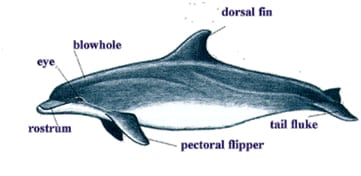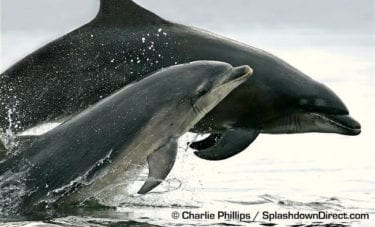Delphinidae
Cetacean Family
Delphinidae
Species within this Family: 37 species 17 genera including
- Cephalorhynchus commersonii: Commerson’s Dolphin
- Cephalorhynchus eutropia: Chilean Dolphin
- Cephalorhynchus heavisidii: Heaviside’s Dolphin
- Cephalorhynchus hectori: Hector’s Dolphin
- Delphinus delphis: Common Dolphin
- Feresa attenuata: Pygmy Killer Whale
- Globicephala macrorhynchus: Short-finned Pilot Whale
- Globicephala melas: Long-finned Pilot Whale
- Grampus griseus: Risso’s Dolphin
- Lagenodelphis hosei: Fraser’s Dolphin
- Lagenorynchus acutus: Atlantic white-sided dolphin
- Lagenohynchus albirostris: White Beaked Dolphin
- Lagenohynchus australis: Peale’s Dolphin
- Lagenohynchus cruciger: Hour Glass Dolphin
- Lagenorhynchus obliquidens: Pacific White-sided Dolphin
- Lagenohynchus obscurus: Dusky Dolphin
- Lissodelphis borealis: Northern right-whale Dolphin
- Lissodelphis peronii: Southern right-whale Dolphin
- Orcaella brevirostris: Irrawaddy Dolphin
- Orcaella heinsohni: Australian Snubfin Dolphin
- Orcinus orca: Killer Whale
- Peponocephala electra: Melon-headed Whale
- Pseudorca crassidens: False Killer Whale
- Sotalia fluiviatilis: Tucuxi
- Sotalia guianesis: Guiana Dolphin
- Sousa chinensis: Indo-Pacific Humpback Dolphin
- Sousa plumbea: Indian Ocean Humpback Dolphin
- Sousa sahulensis: Australian Humpback Dolphin
- Sousa teuszii: Atlantic Humpback Dolphin
- Stenella attenuata: Spotted Dolphin
- Stenella clymene: Clymene Dolphin
- Stenella coeruleoalba: Striped Dolphin
- Stenella frontalis: Atlantic Spotted Dolphin
- Stenella longirostris: Spinner Dolphin
- Steno bredanesis: Rough-toothed Dolphin
- Tursiops aduncus: Indo-Pacific Bottlenose Dolphin
- Tursiops truncatus: Bottlenose Dolphin

Basic dolphin body style. Image by dolphin-art.co.uk
Defining Characteristics
- Fish-like in form, with streamlined, hairless bodies.
- Move through the water using powerful, horizontal flukes
- Flippers and dorsal fin are used for steering.
- Breathe air through a single, dorsal blowhole.
- Dolphins produce an enormous variety of sounds, up to frequencies ten times those heard by human beings. The sounds are apparently produced by a complex of anatomical structures including the blowhole with its air sacs and valves
- Dolphins communicate by means of a demonstrably descriptive language understood by more than one species.
- Their food ranges from herring, cod, mackerel and squid for smaller dolphin species, to larger prey like sea turtles, sea lions, or seals for the killer whale
- Typically have a curved dorsal fin, a ‘beak’ at the front of the head, and a forehead melon
- Travel in large pods, which may number a thousand individuals in some species
- On average, a dolphin with a weight of 200 Kg. to 250 Kg will eat between 10 Kg to 25 Kg of fish every day.
- On average, dolphins sleep 8 hours a day. Half of their brains sleep at a time
- Dolphins carry the longest pregnancy up to 17 months.

Pair of Bottlenose Dolphins breaching
Interesting Facts
- Constantly shedding their skins, dolphins accumulate no barnacles or other external parasites. A layer of blubber protects them from cold and seals small wounds.
- Each dolphin has a signature whistle with which it identifies itself; a calf soon learns to recognize its mother’s whistle.
- Computer-aided efforts are being made, so far without success, to learn the dolphin language and to teach dolphins human speech, either in its normal form or translated into whistle combinations.
- They can convey instructions to another animal.
- The calf is nursed up to 18 months with milk produced by the mother, and the calf stays with their mother for 6 years until they have developed all skills for hunting and survival.
“The dolphin’s intelligence, playfulness, and friendliness, its built-in smile and merry-looking eyes have been a source of interest and enchantment to human beings from earliest times; it is a common figure in mythology and literature and has been much depicted in art, especially in the posture of its graceful, arched, 30-ft (9-m) leap. Dolphins have long been famous for riding the bows of ships, and it is now known that they also ride the bows of large whales. Today they are valued and exploited as entertainers in more than 40 water shows around the world and have thus become available for extensive study.”
Habitat
- Dolphins are found around the world, depending on the species
- They live along the coastline and also offshore in the ocean.
Threats
- Only predator is the shark
- Man
Life Expectancy
- Life Expectancy differentiates amongst each of the species depending on the region. For instance, Bottle Nose Dolphins live to about 40-50 years; whereas some live to 20-25 years.
Works Cited
- Carwardine, Mark. Whales Dolphins and Porpoises. London: Dorling Kindersley Publishing, Inc., 1995. Print
- “Society for Marine Mammalogy – List of Marine Mammal Species and Subspecies.” Society for Marine Mammalogy – Home. N.P., n.d. Web. 8 Mar. 2012.
- <http://www.marinemammalscience.org/index.php?option=com_content&view=article&i d=420:marine-mammal-species-and-subspecies&catid=920:taxonomy&Itemid=340>
- “Dolphin Facts and Information” 8. Mar. 2012 <www.dolphin-world.com>

Killer Whale


